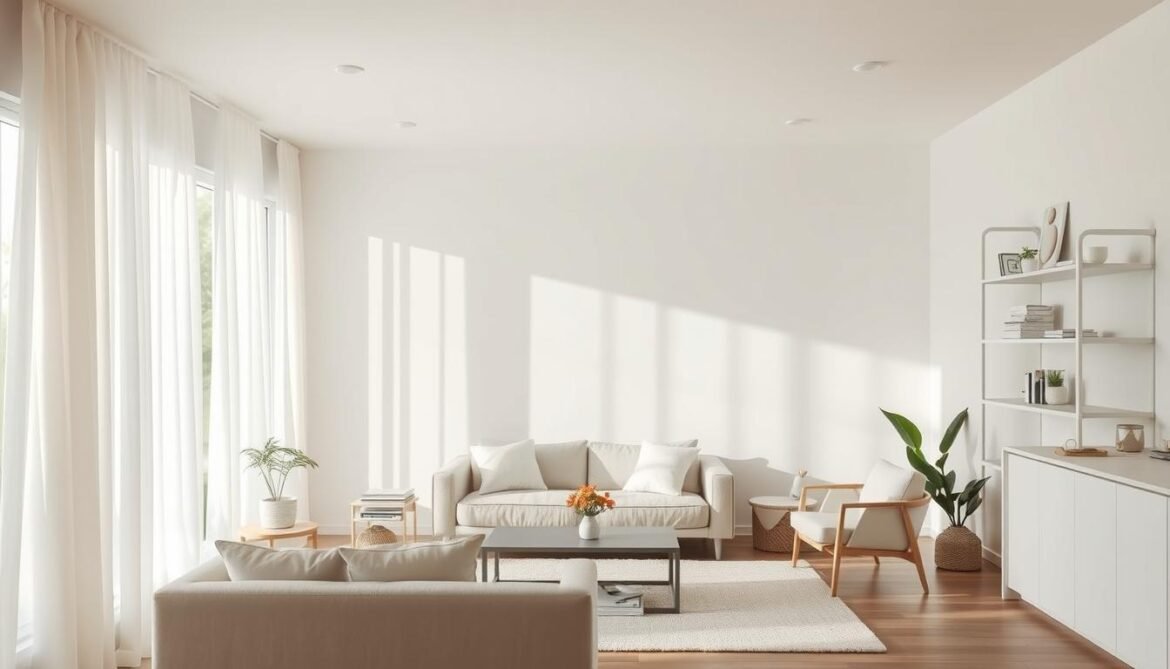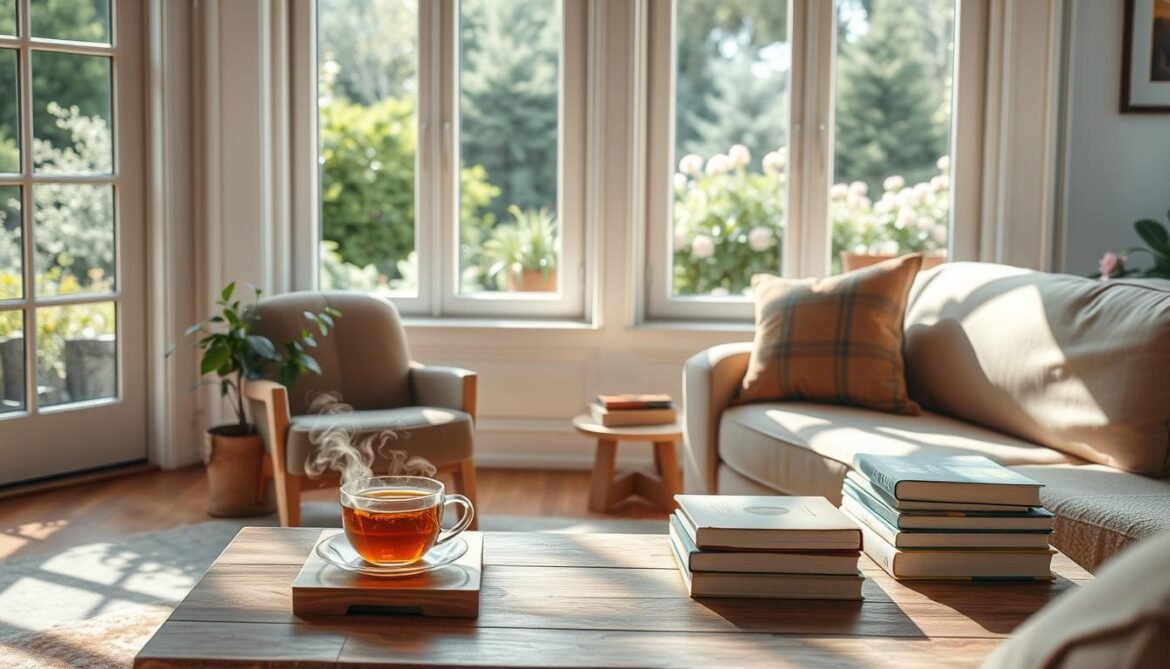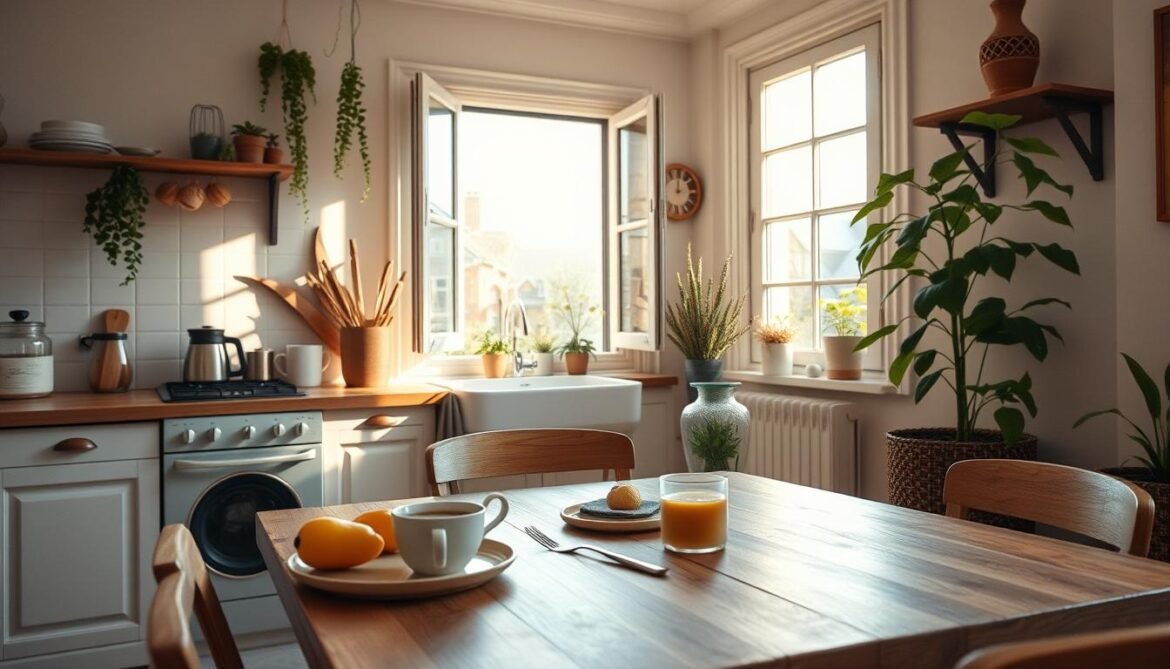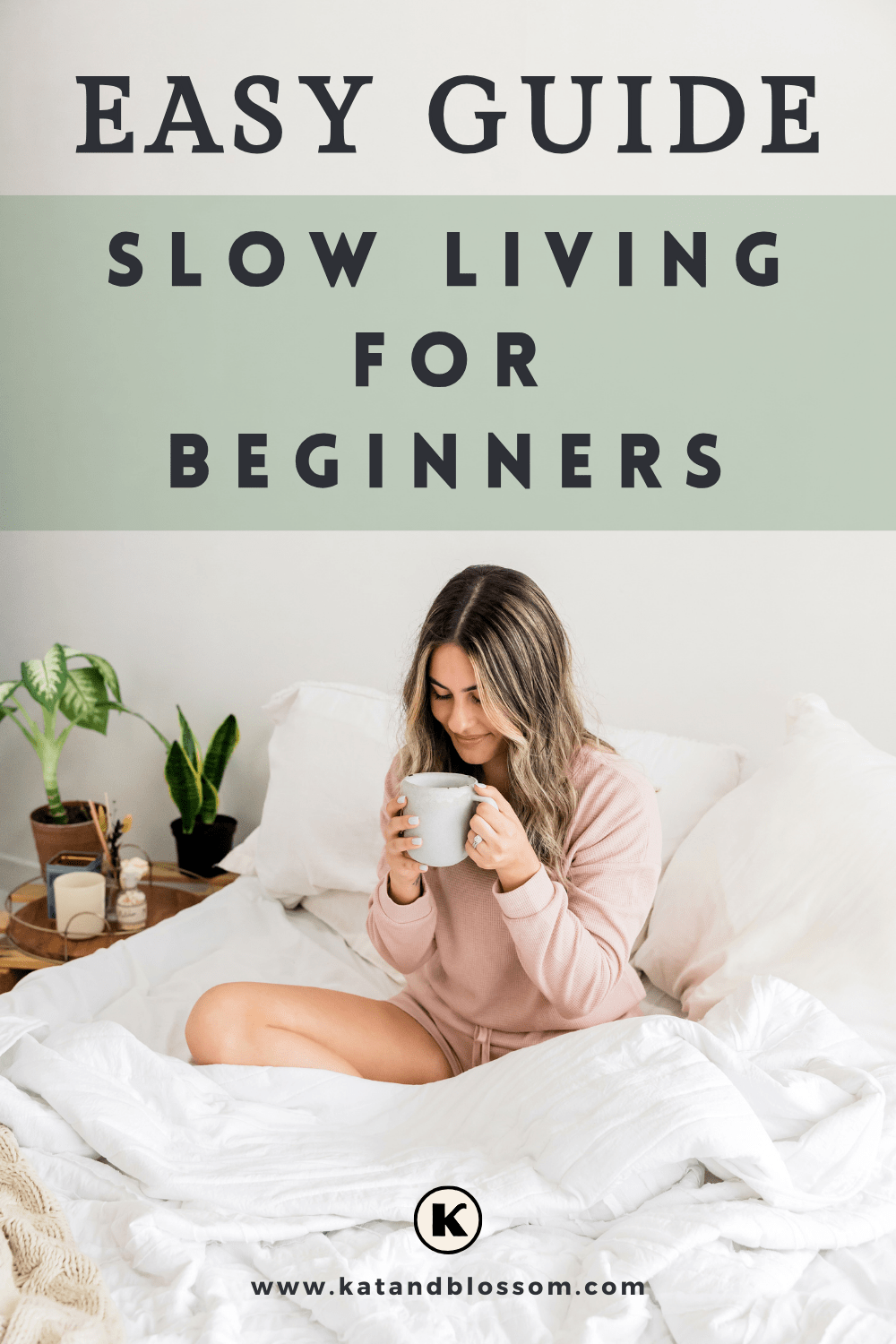Do you feel like you’re always in a rush, missing out on life’s beauty? I did too. That’s when I found slow living. It changed my life, helping me enjoy the simple things and be more mindful.
Slow living isn’t about being slow; it’s about being present and intentional. It’s about having a cozy home, wearing what feels good, and enjoying your food. By simplifying and focusing on quality, you can live more mindfully1.
Imagine waking up to soft light, starting a peaceful day. Or sitting by a fireplace, enjoying your tea. These moments are key to slow living, bringing comfort to your home1.
Here’s some ways you can learn how to start slow living for beginners in this easy guide.

What You’ll Learn
- Slow living focuses on being present and intentional in daily life
- Creating a cozy home environment supports slow living practices
- Decluttering and simplifying your surroundings enhance mindfulness
- Embracing slow living can reduce stress and anxiety2
- Mindful eating and food preparation are essential aspects of slow living
- Understanding Slow Living Philosophy
- Creating a Mindful Home Environment
- How To Slow Living for Beginners: Easy Guide To Get Started
- Simplifying Your Daily Routines
- Conscious Consumption Practices
- Embracing Seasonal Living
- Digital Minimalism and Technology Balance
- Mindful Eating and Food Preparation
- Building Meaningful Relationships
- Connecting with Nature
- Self-Care and Personal Growth
- Conclusion
- FAQ
- Source Links
Understanding Slow Living Philosophy
Slow living is a way of life that focuses on being mindful and intentional. It’s about enjoying every moment and valuing what’s truly important. This idea has become more popular, with a big jump in YouTube videos about it in 20203.
What Defines Slow Living
Slow living means living each day with purpose. It’s about choosing quality over speed, and being fully present. It started in the 1980s in Italy, as a reaction against fast food4.
Benefits of Embracing a Slower Pace
Living slower can make you less stressed and happier. It helps you find a better balance between work and life. This movement is loved worldwide, with fans in over 150 countries3.
Breaking Free from the Hustle Culture
Slow living says that speed isn’t always the best. It teaches you to set limits, focus on your well-being, and say no when needed. This idea has caught many people’s attention, as seen in Carl Honoré’s TED Talk with over 3.3 million views3.
- Slow travel
- Slow gardening
- Slow fashion
- Slow parenting
- Slow working
By embracing minimalism and living intentionally, you can lead a more balanced and meaningful life. This aligns with your values and what’s truly important to you.
| Aspect | Traditional Approach | Slow Living Approach |
|---|---|---|
| Work | Long hours, constant hustle | Balance, quality over quantity |
| Food | Fast food, eating on-the-go | Home-cooked meals, mindful eating |
| Leisure | Packed schedules, multitasking | Intentional activities, being present |
| Consumption | Impulse buying, excess | Thoughtful purchases, minimalism |
Creating a Mindful Home Environment
Your home is your sanctuary. It’s where you recharge and find peace. Let’s explore how to make your living space a haven of tranquility and mindfulness.
Decluttering Your Space
Decluttering is the first step towards a mindful home. Go through your belongings and keep only what brings you joy. This follows the principles of minimalism and conscious consumption. Set aside specific days for cleaning and organizing to keep your home peaceful5.

Decluttering makes your space calm and clear your mind. Your clothes should be simple, like a capsule wardrobe. And cooking at home, eating with others, builds connection1.
Incorporating Natural Elements
Bring nature indoors for a calming atmosphere. Add houseplants or fresh flowers to your living areas. Natural elements purify the air and connect you with the outside world. This connection helps you adjust to a natural rhythm and enjoy each moment6.
Setting Up Cozy Corners
Create inviting nooks in your home for relaxation. Use soft lighting, comfortable furnishings, and warm, neutral colors. These cozy spaces are perfect for mindfulness or quiet moments.
Creating a mindful home is an ongoing process. It’s about making intentional choices and being mindful of your surroundings6. By choosing quality over quantity and supporting small businesses, you align your home with slow living principles5.
“Your home should be the antidote to stress, not the cause of it.”
By using these strategies, you’re not just making a beautiful space. You’re creating an environment that supports your well-being and reduces stress and anxiety6. Your mindful home will show your commitment to slow living and conscious consumption.
How To Slow Living for Beginners: Easy Guide To Get Started

Starting a slow living journey doesn’t need big changes or a lot of money7. Begin by making your space simpler and focusing on what’s important. Use the KonMari Method to declutter and set up cleaning routines for each season8. This helps you live more mindfully.
Choose quality over quantity in what you buy and do. Support small businesses that share your values, like local artists or eco-friendly brands8. This way, you make your living space better and help the planet.
Make every day moment count by being present and appreciative. Here are some tips:
- Eat mindfully to improve digestion and enjoy your food more87.
- Focus on one task at a time to work better and feel less stressed8.
- Take breaks to clear your mind8.
- Make areas tech-free to connect more with people87.
Learn to say no to things that don’t fit your values or goals89. This saves your time and energy for what’s important. Remember, small steps are better for a slower pace of life7.
“The key to slow living is not about slowing down time, but about being present and intentional with the time we have.”
Try these mindful living habits in your daily life:
| Practice | Benefit |
|---|---|
| Daily nature walks | Reduces stress, enhances creativity |
| Gratitude journaling | Increases positivity and contentment |
| Digital detox periods | Reduces mental clutter |
| Embracing JOMO | Promotes intentional living |
By making these simple changes, you’ll naturally slow down and enjoy life more. Slow living is a journey, not a goal. Enjoy the calm it brings to your daily life.
Simplifying Your Daily Routines
Streamlining your daily routines can make life more balanced and fulfilling. Focus on mindful practices and time management. This way, you can create a self-care routine that boosts your well-being and cuts down stress.
Morning Rituals
Begin your day with a calming morning ritual. This could be meditation, gentle stretching, or a quiet cup of tea. Waking up early gives you time for these activities and helps you sleep better10.
Evening Wind-down Practices
Set up a soothing evening routine for better sleep. Stay away from screens before bed and do relaxing activities like reading or stretching. Also, keep your phone out of the bedroom10. These habits can greatly improve your sleep and energy during the day.
Mindful Time Management
Good time management is key to a balanced life. Prioritize tasks, avoid overcommitting, and set work boundaries. Schedule personal time on your calendar10. Single-tasking over multitasking boosts productivity and focus.

- Make a simple cleaning schedule for daily, weekly, and monthly tasks
- Start rituals like weekly family dinners or monthly outings with friends
- Do hobbies like knitting, painting, or playing music to disconnect from tech10
- Spend at least 120 minutes in nature weekly for better health and well-being11
Remember, simplifying your routines is not about cutting out activities. It’s about focusing on what truly matters. By adopting these practices, you can live a more balanced and fulfilling life that supports slow living principles.
| Activity | Benefit | Time Commitment |
|---|---|---|
| Morning Meditation | Reduced Stress | 15-30 minutes |
| Evening Reading | Improved Sleep | 30-60 minutes |
| Nature Time | Enhanced Well-being | 120 minutes weekly |
| Single-Tasking | Increased Productivity | Throughout the day |
Conscious Consumption Practices
Embracing conscious consumption is key to sustainable living. It means buying less and choosing items that reflect your values. This approach helps reduce clutter and supports ethical shopping12.

The slow living movement started in 1980s Rome. It now covers all aspects of life, including how we consume12. It teaches us to use what we need and make the most of what we have. This can lead to fewer possessions13.
To practice conscious consumption:
- Support small businesses and sustainable brands
- Consider the environmental impact of your purchases
- Choose timeless, durable products
- Resist impulse buying
- Use up existing items before buying new ones
Monitoring and controlling spending is key to slow living12. Ask yourself important questions before buying. This ensures your purchases match your values and support a minimalist lifestyle.
“Do I really need this item? Will it add value to my life? Is there a more sustainable alternative?”
Changing to conscious consumption takes time and patience. Start with small steps and gradually add them to your life13. By linking these changes to your values, you’re more likely to adopt a mindful consumption approach12.
| Conscious Consumption Practice | Benefit |
|---|---|
| Buying quality over quantity | Reduces waste and saves money long-term |
| Supporting ethical brands | Promotes fair labor practices and sustainability |
| Practicing minimalism | Decreases clutter and increases focus on essentials |
| Repairing and upcycling | Extends product life and reduces landfill waste |
Embracing Seasonal Living
Seasonal living helps you connect with nature’s cycles and live sustainably. It encourages you to slow down and enjoy each season’s unique offerings14.
Aligning with Natural Rhythms
Let the seasons guide your daily life. In cold months, enjoy indoor hobbies. When it warms up, get outside and explore. This way, you feel closer to your surroundings14.
Seasonal Food and Activities
Eat foods that are in season to support local farmers and get the best nutrition. Make a list of seasonal activities to look forward to each year1415.
| Season | Food | Activities |
|---|---|---|
| Spring | Asparagus, Strawberries | Gardening, Nature Walks |
| Summer | Tomatoes, Watermelon | Beach Trips, Outdoor Concerts |
| Fall | Pumpkins, Apples | Leaf Peeping, Harvest Festivals |
| Winter | Root Vegetables, Citrus | Skiing, Indoor Crafts |
Creating Seasonal Traditions
Make special traditions for each season. This could be fall cleaning, winter gatherings, or spring picnics. These rituals help you feel connected to nature and provide a sense of continuity1516.
Embracing seasonal living makes you more mindful and connected to nature’s cycles. It promotes a slower, more thoughtful way of living that harmonizes with nature’s rhythms1416.
Digital Minimalism and Technology Balance
In today’s world, it’s key to find a balance with technology. Digital minimalism helps you use tech mindfully, saving time and focus. Let’s look at ways to detox from screens and improve your tech use.

Begin by tracking how much time you spend on devices. This can show you how much you’re using tech. Set limits, like checking social media only twice a day, to balance digital and real-life activities17.
Make tech-free areas in your home, like bedrooms or dining rooms. This helps you have more face-to-face time. Try an automatic Do Not Disturb mode from 9 pm to 6 am, with exceptions for urgent texts18.
Clear out apps and emails you don’t need. This makes your mind clearer and helps you focus on important things17. Use a paper notebook for planning instead of apps to cut down on screen time18.
| Digital Minimalism Strategy | Benefits |
|---|---|
| Set tech-free times | Improved focus and real-world engagement |
| Declutter digital spaces | Reduced mental fatigue and increased productivity |
| Use analog tools | Enhanced creativity and reduced screen dependency |
By following these digital minimalism tips, you can use your phone less. Some people have cut their daily phone time to 62 minutes, down from 3 to 5 hours in the U.S18.. This mindful approach to tech can make you happier and more balanced in your digital and physical life17.
Mindful Eating and Food Preparation
Start enjoying meals more by practicing mindful eating and slow food preparation. This method helps you appreciate each bite and the joy of cooking from scratch.
Cooking from Scratch
Homemade meals let you connect with your food in a special way. Using fresh ingredients and cooking slowly makes your meals healthy and fulfilling. It also means you control what you eat, cutting down on processed foods.
Mindful Meal Planning
Plan your meals with care, using seasonal and local foods. This approach cuts down on waste and saves money, ensuring a healthy diet19. It also helps you avoid unhealthy snacks between meals19.
Creating Food Rituals
Make eating special by creating meaningful rituals. Try having tech-free dinners or hosting monthly potlucks. Saying thanks before meals can also deepen your appreciation for food. These habits can lead to a healthier eating relationship and less stress19.
“Mindful eating is not about being perfect, restrictive, or overly obsessive. It’s about focusing on food as nourishment and savoring every bite.”
Studies show mindful eating helps with weight loss, reduces binge eating, and boosts well-being20. One study found that mindful eating training led to a 4-pound weight loss on average20. By making these habits part of your life, you can enjoy a healthier relationship with food and the benefits of slow, mindful eating.
| Mindful Eating Benefits | Traditional Diet Programs |
|---|---|
| Sustainable weight loss | 80% weight regain after 5 years |
| Reduced binge eating episodes | Often leads to yo-yo dieting |
| Improved emotional eating control | May not address underlying issues |
| Enhanced overall well-being | Focus mainly on weight loss |
Building Meaningful Relationships
In the slow living lifestyle, making deep connections is key. Focus on quality time with others, not just being busy. This helps build a strong sense of community and lasting bonds. It’s all about living simply and focusing on what’s truly important21.
To build meaningful relationships, try these steps:
- Create traditions or regular gatherings with loved ones
- Practice active listening during interactions
- Participate in local events or volunteer activities
- Limit screen time to be more present with others
Studies show that living intentionally can make life more balanced. By making routines into rituals, you add meaning to your daily life22. This mindset helps you connect more deeply with others.
Slow living teaches us to value leisure and meaningful relationships more22. By focusing on nurturing your connections, you’re living simply. This simple way of living boosts your overall well-being21.
| Slow Living Principle | Application to Relationships |
|---|---|
| Closer to Source | Prioritize in-person interactions |
| Turning Routines into Rituals | Create meaningful traditions with loved ones |
| Downshifting | Allocate more time for quality relationships |
By living these principles, you’ll strengthen your relationships. These bonds will make your slow living journey richer.
Connecting with Nature
Slow living emphasizes the importance of nature connection. Outdoor living and sustainable gardening help you bond with nature. This can bring peace into your daily life.
Daily Nature Practices
Adding nature to your daily routine can lower stress and boost well-being. Nature walks are great for unwinding and reconnecting. They clear your mind and help you focus23.
Outdoor Activities
Outdoor activities let you dive deep into nature. Try hiking, birdwatching, or just sitting in a park. These activities help you slow down and enjoy life’s beauty. They teach you to value simplicity and what’s truly important24.
Growing Your Own Food
Sustainable gardening connects you with nature. Start with herbs on your windowsill or a small veggie patch. It gives you fresh food and makes you appreciate what you eat.
| Nature Connection Practice | Benefits |
|---|---|
| Daily Nature Walks | Stress relief, mental clarity |
| Outdoor Activities | Improved well-being, mindfulness |
| Sustainable Gardening | Fresh produce, environmental awareness |
These nature-focused practices lead to a more mindful life. Slow living is about making thoughtful choices, not rushing. Regularly connecting with nature can make your life more fulfilling24.
Self-Care and Personal Growth
Slow living means focusing on self-care and personal growth. Spend just 5 minutes each day on meditation. This helps ground your energy and brings you to the present moment25. It can make you feel calmer and freer26.
Make journaling a part of your daily routine. It helps with reflection and clarity. It also strengthens your connection to yourself and your spirituality26. Begin each day with gratitude to boost your well-being26.
Decluttering is key to personal growth. It clears physical space and your mind. This lets you live more mindfully and gratefully2526.
“Self-care is not selfish. You cannot serve from an empty vessel.” – Eleanor Brown
Self-care is vital for a balanced life26. Begin your slow living journey with small, lasting changes. Start with one area and then move to others25. Embracing this lifestyle may face challenges, but the benefits to your growth and well-being are worth it26.
Conclusion
Slow living is a journey that changes your life for the better. It helps you focus on what’s important and enjoy the little things more27.
Slow living isn’t about doing less. It’s about choosing how to spend your time wisely. It’s a journey of self-discovery and living with purpose2829.
To start slow living, begin with small steps. Try mindful eating, digital detoxes, or morning rituals. These small changes can make a big difference in your well-being. You’ll learn to appreciate life’s simple joys and feel more present and grateful2729.
Transitioning to a slower pace can be tough. But it’s worth it. Learn to say “no” to things that don’t matter, simplify your life, and make room for meaningful experiences. This way, you’ll find true happiness, balance, and purpose in your life2829.
FAQ
What is slow living?
How can I start practicing slow living?
What are the benefits of slow living?
How can I create a mindful home environment?
What is conscious consumption?
How can I practice digital minimalism?
What is mindful eating?
How can I connect with nature through slow living?
How can I balance slow living with a busy schedule?
How does slow living relate to minimalism?

Source Links
- Slow Living 101 – https://theslowlivingguide.co.uk/slow-living-101/
- What Is Slow Living? Slow Living For Beginners – Green With Less – https://greenwithless.com/slow-living-for-beginners/
- What is slow living? Slow movement history, tips, resources | Slow Living LDN. – https://slowlivingldn.com/what-is-slow-living/
- How to Embrace the Art of Slow Living – https://comehomewithbonniejean.com/how-to-embrace-the-art-of-slow-living/
- Slow living guide for beginners – 7 simple ways to start today – https://yrstudio.co.uk/blogs/adriana-tudorache-blog/ultimate-guide-slow-living-simplify-life-find-joy?srsltid=AfmBOoochmKEzXFHsHnfaobMwEUOg14BuwxLtHYPQKw70IiVqlLvp7PL
- A Guide to Slow and Simple Living – https://nosidebar.com/a-guide-to-slow-and-simple-living/
- A Beginners Guide to Slow Living — Field & Nest – https://where-ever.co.uk/journal/a-beginners-guide-to-slow-living
- Slow living guide for beginners – 7 simple ways to start today – https://yrstudio.co.uk/blogs/adriana-tudorache-blog/ultimate-guide-slow-living-simplify-life-find-joy?srsltid=AfmBOopptthoiOJcIWJjs0FPAw58SUXdXCAcQ4bVh4JLp6KMFEkUwrKS
- Slow Living Guide: 12 Tips for Mindful Living | Wild Linens – https://wildlinens.com/pages/slow-living-guide?srsltid=AfmBOorgB4UpnywscX84Cel9rS4rCSp1CVo73SW4ety13JsdTe5M_Qmv
- Why Soft and Slow is the new Busy – https://bemorewithless.com/living-slowly/
- A Beginner’s Guide to Slow Living – https://balancethroughsimplicity.com/beginners-guide-slow-living/
- Slow Living for Beginners: 14 Easy Ways to Live More Slowly – https://lowimpactlove.com/slow-living-for-beginners/
- The Simple Art of Slow Living – Boots & Hooves Homestead – https://bootsandhooveshomestead.com/the-art-of-slow-living/
- seasonal slow living: a simple way to approach slow living — Slow Morning Diaries – https://www.slowmorningdiaries.com/blog/seasonal-slow-living
- The Seasonal Slow Living Way to Welcome Autumn – https://www.jmbliving.com/blogs/blog/the-seasonal-slow-living-way-to-welcome-autumn?srsltid=AfmBOoov2pLjRebo90jeTBpwfU_I-6cUtC7gjbV7FEXK91ZLk8ax9a_2
- Slow living guide for beginners – 7 simple ways to start today – https://yrstudio.co.uk/blogs/adriana-tudorache-blog/ultimate-guide-slow-living-simplify-life-find-joy?srsltid=AfmBOoo5_7Q8YLnpTQgwyAjl3CABHRnC50ic74mD3inBapBCbtvZrjDY
- Digital Minimalism: Where to Start and What to Aim For – https://teekayrezeaumerah.medium.com/digital-minimalism-where-to-start-what-to-aim-for-no-bs-b62caea7ce03
- How I Got Digital Minimalism Right The Second Time Around – https://www.becomingminimalist.com/digital-minimalism/
- A beginner’s guide to mindful eating – The Lifestyle Files – https://www.thelifestyle-files.com/beginners-guide-mindful-eating/
- Mindful Eating 101 — A Beginner’s Guide – https://www.healthline.com/nutrition/mindful-eating-guide
- The Best Simple Living Tips: An Essential Guide for Beginners – https://comehomewithbonniejean.com/simple-living-an-essential-guide-for-beginners/
- How To Discover The Joy Of Slow Living Now: A Complete Guide – https://tastefullyminimalist.com/slow-living/
- A Beginner’s Guide to Slow Living – https://medium.com/practice-in-public/a-beginners-guide-to-slow-living-0adb46902fd7
- Slow Living Guide: 12 Tips for Mindful Living | Wild Linens – https://wildlinens.com/pages/slow-living-guide
- How To Live A Happy Life Through The Art Of Slow Living – https://hisensitives.com/blog/live-happiest-life-slow-living/
- Unplug And Unwind: Ultimate Guide To Slow Living In A Fast-Paced World – Jules Simon – https://xojulessimon.com/guide-to-slow-living/
- The Exact Daily Routine I’m Using To Finally Embrace Slow Living – Jules Simon – https://xojulessimon.com/routine-slow-living/
- Embracing Slow Living: A Journey of Mindful Transformation – https://rizkifadhilahmhabibi.medium.com/embracing-slow-living-a-journey-of-mindful-transformation-89c029f5b331
- BACK TO THE SLOW LIFE: What Slow Living Really is About – The Pocket Journal – https://thepocketjournal.com/back-to-the-slow-life-what-slow-living-really-is-about/















